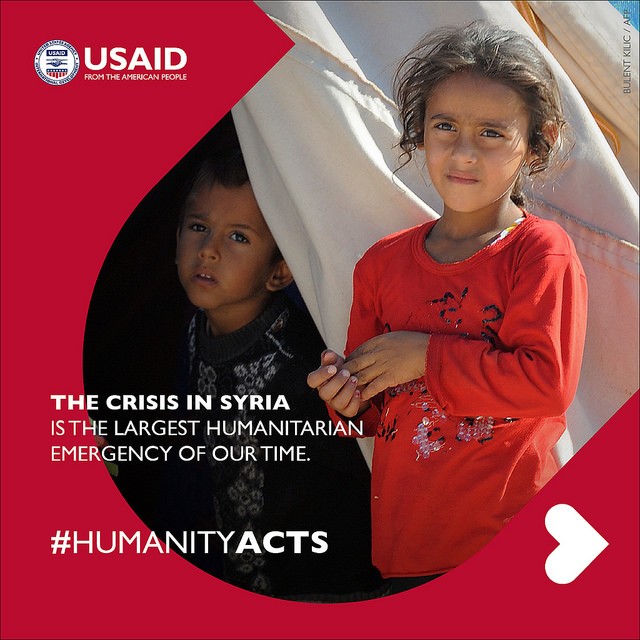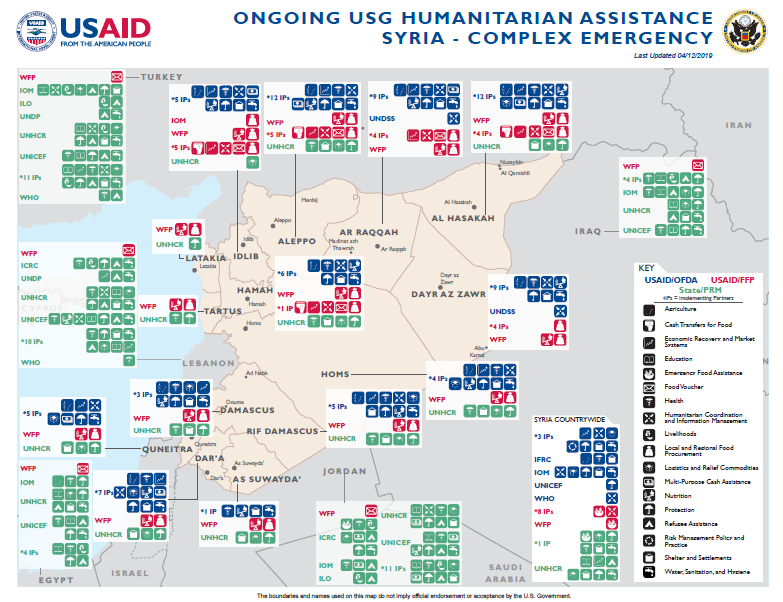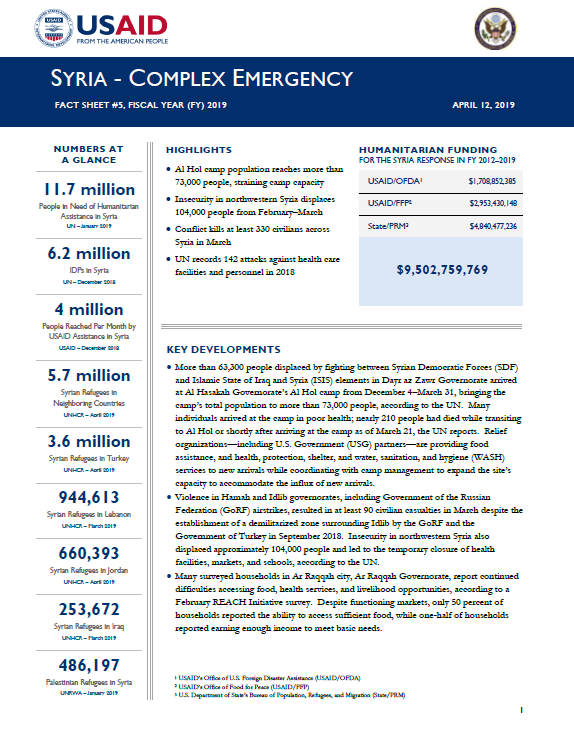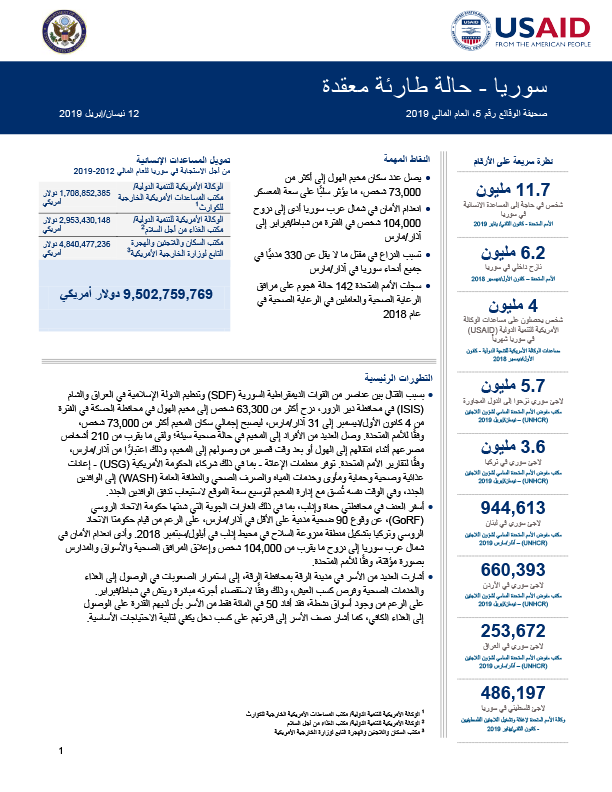- What We Do
- Agriculture and Food Security
- Democracy, Human Rights and Governance
- Economic Growth and Trade
- Education
- Environment and Global Climate Change
- Gender Equality and Women's Empowerment
- Global Health
- Humanitarian Assistance
- Transformation at USAID
- Water and Sanitation
- Working in Crises and Conflict
- U.S. Global Development Lab
Speeches Shim
April 12, 2019
Highlights
Al Hol camp population reaches more than 73,000 people, straining camp capacity
Insecurity in northwestern Syria displaces 104,000 people from February–March
Conflict kills at least 330 civilians across Syria in March
UN records 142 attacks against health care facilities and personnel in 2018
Key Developments
More than 63,300 people displaced by fighting between Syrian Democratic Forces (SDF) and Islamic State of Iraq and Syria (ISIS) elements in Dayr az Zawr Governorate arrived at Al Hasakah Governorate’s Al Hol camp from December 4–March 31, bringing the camp’s total population to more than 73,000 people, according to the UN. Many individuals arrived at the camp in poor health; nearly 210 people had died while transiting to Al Hol or shortly after arriving at the camp as of March 21, the UN reports. Relief organizations—including U.S. Government (USG) partners—are providing food assistance, and health, protection, shelter, and water, sanitation, and hygiene (WASH) services to new arrivals while coordinating with camp management to expand the site’s capacity to accommodate the influx of new arrivals.
Violence in Hamah and Idlib governorates, including Government of the Russian Federation (GoRF) airstrikes, resulted in at least 90 civilian casualties in March despite the establishment of a demilitarized zone surrounding Idlib by the GoRF and the Government of Turkey in September 2018. Insecurity in northwestern Syria also displaced approximately 104,000 people and led to the temporary closure of health facilities, markets, and schools, according to the UN.
Many surveyed households in Ar Raqqah city, Ar Raqqah Governorate, report continued difficulties accessing food, health services, and livelihood opportunities, according to a February REACH Initiative survey. Despite functioning markets, only 50 percent of households reported the ability to access sufficient food, while one-half of households reported earning enough income to meet basic needs.
Syria Complex Emergency - Map #5 FY19 ![]() (pdf - 460k)
(pdf - 460k)
Numbers At A Glance
11.7 million
6.2 million
4 million
5.7 million
3.6 million
944,613
660,393
253,672
486,197
Humanitarian Funding
To Syria Humanitarian Response
FY 2012 - FY 2018
| USAID/OFDA | $1,708,852,385 |
| USAID/FFP | $2,953,430,148 |
| State/PRM | $4,840,477,236 |
| TOTAL | $9,502,759,769 |
Syria Complex Emergency - Fact Sheet #5 FY19 ![]() (pdf - 337k)
(pdf - 337k)
5 سوریا حالة طارئة معقدة - صحیفة الوقائع رقم ![]() (pdf - 248k)
(pdf - 248k)
INSECURITY, DISPLACEMENT
Conflict in Syria killed at least 330 civilians during March, of which at least 150 deaths resulted from Syrian Arab Republic Government (SARG) and GoRF military operations, according to the Syria Network for Human Rights (SNHR). SNHR has recorded nearly 780 civilian deaths in Syria to date in 2019
Northeastern Syria
Between December 4 and March 31, populations fleeing conflict between SDF and ISIS in Dayr az Zawr continued to arrive at Al Hol, bringing the camp’s total population to more than 73,000 people, approximately 90 percent of whom are women and children, the UN reports. However, the number of new arrivals has decreased in recent weeks with approximately 500 additional people arriving at Al Hol between March 24 and 31, a more than 80 percent decrease from the nearly 2,700 people who arrived from March 14–20, the UN reports.
The influx of more than 63,300 people since December 4 has strained the capacity of Al Hol, which was originally intended to support up to 41,000 people. Overcrowding and limited access to services have also contributed to increased tensions at the site. On March 21, clashes between displaced persons and local security forces resulted in one death, injured eight people, and prompted the temporary suspension of relief services, the UN reports.
Northwestern Syria
Violence in northwestern Syria continues to threaten and displace civilians, with artillery shelling reported across Idlib and northern Hamah from early February to early April, according to the UN. Airstrikes, improvised explosive attacks in urban areas, and shelling along frontlines resulted in approximately 90 civilian deaths in March and prompted health facilities, markets, and schools to temporarily close in Idlib and Hamah, the UN reports. Insecurity also displaced more than 104,000 people in northwestern Syria from February–March.
On March 12, a GoRF airstrike killed two people and injured at least 10 civilians in an internally displaced person (IDP) camp located near Idlib’s Kafr Amim village. Additionally, airstrikes and shelling in early April resulted in at least 19 civilian deaths and injuries to at least 25 people in Idlib and Hamah, the UN reports.
SHELTER AND PROTECTION
Despite widespread shelter damage, displaced populations continue to return to areas of origin in Ar Raqqah city, according to a February REACH Initiative survey. Nearly half of surveyed households in the city’s Bain al-Jisreen, Al Basil, and Qitar neighborhoods were residing in houses with significant damage as of February. However, shelter reconstruction activities remain limited, REACH reports.
Relief actors installed nearly 10,700 household tents at Al Hol from December to March, the UN reports. However, recent heavy rains and lack of available plots prompted relief organizations to temporarily suspend tent distributions. Despite plans to expand the camp, nearly 1,370 additional tent plots are required to accommodate the camp’s population, the UN reports. As of March 31, approximately 19,000 people were sheltering in communal spaces or multi-household tents, according to the UN.
Populations at Al Hol are in need of expanded protection services, including case management, psychosocial assistance, and support for an estimated 600 persons with disabilities at the site. More than 90 percent of individuals in the camp are women and children and relief actors had identified nearly 360 unaccompanied or separated children as of March 31, the UN reports. Overcrowding in the camp and disruptions to social safety nets have increased the risks of gender-based violence (GBV), leaving women and girls in need of GBV prevention and response services and dignity kits, according to the UN. Relief actors have also noted the need to improve lighting near WASH facilities and provide gender-segregated facilities to minimize the risk of GBV.
In response to child protection needs and broader protection concerns at Al Hol, approximately 40 humanitarian protection staff and volunteers are supporting new arrivals in the camp’s reception center and screening areas, according to the Protection Sector. From January–March, the UN Children’s Fund (UNICEF) facilitated the reunification of nearly 60 separated children with their families and provided accommodations for more than 100 unaccompanied children in three interim care centers. Humanitarian organizations are also operating six child-friendly spaces and two women and girl safe spaces at Al Hol and providing protection services to 12,000 children, while the UN Population Fund (UNFPA) provided GBV services to nearly 3,560 people through four mobile GBV response teams from March 24–April 1.
Individuals continue to return to areas of origin in Rif Damascus Governorate’s Eastern Ghouta region and surrounding areas, despite damaged infrastructure and limited access to basic services, the UN reports. In response to acute protection needs among conflict-affected populations, including recent returnees, a USAID/OFDA partner conducted psychosocial support activities for nearly 170 children in Eastern Ghouta in February.
HEALTH AND WASH
Attacks against health facilities continued to hinder access to essential health care services for vulnerable populations across Syria in 2018, with the UN recording at least 142 attacks against health facilities and personnel during the year. The attacks killed more than 100 people—including 18 health workers—and injured nearly 190 others, the UN reports. The incidents represent a more than 16 percent increase from the 122 health facility attacks recorded by the UN in 2017, which killed 73 people and injured 150 people.
Despite an overall reduction in hostilities in many areas of the country, nearly 50 percent of public hospitals in Syria were either non-functional or only partially functional due to ongoing insecurity as of December 2018, the UN World Health Organization (WHO) reports. The majority of non-functional or partially functional public hospitals were located in Al Hasakah, Ar Raqqah, Dar’a, Dayr az Zawr, and Homs governorates; there were no functional public hospitals in Idlib as of late 2018, according to WHO.
Health actors reported more than 600 cases of leishmaniosis—a parasitic disease caused by bites from certain types of sandflies—in Dayr az Zawr between February 24 and March 2, according to WHO. The number of newly identified cases represents a 60 percent decrease from mid-December, when health organizations recorded nearly 1,500 new cases. In response, WHO is training 25 laboratory technicians on leishmaniosis diagnosis in Dayr az Zawr, Al Hasakah, and Ar Raqqah and providing medical supplies to support a national leishmaniosis control program.
Many households in Ar Raqqah city report an inability to access essential health services, particularly for child birth and chronic disease treatment, due to cost of services and distances to facilities, according to a late February REACH Initiative survey. However, access to the primary water network in the city has improved since October 2018, with nearly all surveyed households reporting sufficient access to water, although water quality and sanitation issues remain.
Displaced persons fleeing violence in Dayr az Zawr’s Al Baghouz village and Hajin sub-district continue to arrive at Al Hol in poor health, the UN reports. The majority of new arrivals report suffering from fatigue, injuries, and malnutrition due to prolonged exposure to hostilities and lack of access to food and basic services. Nearly 210 individuals died while transiting to the camp or shortly after arrival primarily due to complications related to dehydration, diarrhea, pneumonia, and complications from severe acute malnutrition (SAM) from December 4 to March 29; infants younger than 12 months of age comprise more than half of registered deaths, according to WHO.
Health actors provided medical care to approximately 14,700 people at Al Hol from March 21–31, the UN reports. Health organizations also vaccinated nearly 12,700 children ages five years and younger against polio and more than 5,300 children against measles from December 9 to March 21. However, the UN reports that the site requires additional health care services to meet the population’s needs, expand disease surveillance systems, improve trauma care capacity, and increase reproductive health care services, according to the UN. Additionally, the network of referral hospitals needs to be expanded, as approximately 30–50 cases—primarily injuries and malnutrition cases—are referred to two hospitals in Al Hasakah daily, stretching the capacity of the hospitals to accommodate increased caseloads.
The population influx to Al Hol since early December has significantly strained WASH facilities and services at the camp. In response to increased needs, WASH organizations—including USAID/OFDA partners—are delivering approximately 1.5 million liters of water to the camp daily and have installed more than 2,500 latrines and bathing facilities, approximately 620 solid waste containers, and 480 water tanks, the UN reports. Although the construction of 400 more latrines is ongoing, approximately 1,350 additional latrines and bathing facilities are required in order to meet the needs of the camp population, according to the UN.
FOOD SECURITY, LIVELIHOODS, AND NUTRITION
Food security conditions deteriorated in UN-designated hard-to-reach (HTR) areas of Hamah and Homs between January and February, according to a recent UN World Food Program (WFP) assessment. Nearly 50 percent of households surveyed in HTR areas of Hamah and Homs reported either poor or borderline food consumption levels—based on a three-tier classification system determined by the frequency, diversity, and nutritional value of consumed foods—in February, a significant increase from the 16 percent of households that reported poor or borderline food consumption levels in January. In addition, surveyed households reported frequently resorting to negative coping strategies—including limiting meals and portion size, as well as the amount of food adults consume—to meet food needs, according to WFP.
Despite the presence of functional markets, less than 50 percent of surveyed households in Ar Raqqah city were able to access enough food to meet basic needs, resulting in the use of negative coping strategies such as borrowing money to pay for food and reducing meal size, according to a late February REACH Initiative assessment. Relatedly, populations are experiencing significant challenges in accessing livelihood opportunities, with only 50 percent of households reporting earning enough income to meet basic needs.
Food security and nutrition organizations continue to respond to humanitarian needs at Al Hol camp. As of April 1, food security actors, including USAID/FFP partners, had provided monthly food rations to the more than 73,000 people at the camp; ready-to-eat food rations to approximately 63,300 people; and cooked meals to nearly 61,800 people at Al Hol, the UN reports. From January 1–March 23, nutrition and health actors screened more than 21,300 children younger than five years of age for acute malnutrition, identifying 560 children experiencing moderate acute malnutrition (MAM) and 250 children experiencing SAM without complications. Nutrition actors also identified more than 300 children experiencing SAM with complications, and referred the children to hospitals in Al Hasakah for treatment, according to the UN.
With USAID/FFP support, WFP delivered emergency food assistance to approximately 3.3 million people throughout Syria’s 14 governorates—including approximately 266,000 people in 43 HTR areas in Dayr az Zawr, Homs, Quneitra, Ar Raqqah, and Rif Damascus governorates—in February, representing a nearly 30 percent increase from the 2.4 million people assisted in January. Additionally, WFP livelihood activities, including farming support, food processing, and vocational training, benefitted more than 132,000 people across 11 governorates in February.
WFP provided nutrition supplies for the prevention of acute malnutrition to more than 94,000 children in 11 governorates in February. WFP also delivered supplies for MAM treatment to nutrition centers and mobile clinics, sufficient to treat nearly 2,700 individuals for one month. Additionally, approximately 41,500 pregnant and lactating women received WFP-provided cash-based transfers to purchase nutritious foods through more than 70 WFP-contracted shops during February.
REFUGEE ASSISTANCE
More than 75 percent of surveyed Syrian refugees in Egypt, Iraq, Jordan, and Lebanon hope to eventually return to Syria, according to an Office of the UN High Commissioner for Refugees (UNHCR) intentions survey conducted between November 2018 and February 2019. However, refugee returns remain dependent on security conditions and availability of basic services, livelihood opportunities, and shelter in areas of origin or preferred destinations within Syria, as well as the possibility of exemption from military service; as such, only 6 percent of respondents planned to return to Syria within the next 12 months. Of the respondents unwilling to return, 75 percent expressed a desire to remain in regional host countries, while 20 percent were considering relocating to another country, UNHCR reports.
Following severe winter storms in Lebanon’s Akkar and North governorates in late February, which affected 160 households across 48 refugee sites, USG partner UNICEF distributed more than 50 hygiene kits and 25 children’s clothing kits, and conducted desludging activities at 20 sites, benefitting nearly 1,170 people.
PUBLIC DONATION INFORMATION
The most effective way people can assist relief efforts is by making cash contributions to humanitarian organizations that are conducting relief operations. A list of humanitarian organizations that are accepting cash donations for disaster responses around the world can be found at www.usaid.gov/crisis/syria.
The USG encourages cash donations because they allow aid professionals to procure the exact items needed (often in the affected region); reduce the burden on scarce resources (such as transportation routes, staff time, and warehouse space); can be transferred very quickly and without transportation costs; support the economy of the disaster-stricken region; and ensure culturally, dietary, and environmentally appropriate assistance.





Comment
Make a general inquiry or suggest an improvement.